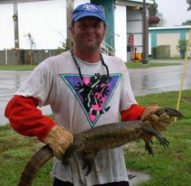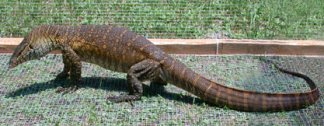Scientist’s Notebook
Why did you decide to study Nile monitors?
They’re big and interesting. But, more importantly, I saw the potential for them to eat native birds on Sanibel Island in the JN “Ding” Darling National Wildlife Refuge, one of Florida’s most important bird sanctuaries.
 |
| Todd Campbell holds a Nile monitor. |
| Courtesy of Todd Campbell |
What do they eat?
They get up to 7 feet long and are predators—true top carnivores. They are at the top of the food chain and, in their native lands of Africa, eat everything—crustaceans, insects, mollusks, fish, amphibians, reptiles, birds, bird eggs, and mammals. Anything they cannot fit into their mouths, they will simply tear apart with their sharp claws.
How do Nile monitors fit into the broader problem of introduced species?
They are truly novel in North America, but they are not unlike many other invaders. We have a novel predator with very few species that would control it (except us), and it pretty much does whatever it wants. Lots of invaders are like that. They escape from their native predators and parasites and competitors and go nuts in their new lands.
 |
| A Nile monitor in a cage in Todd Campbell’s backyard. |
| Courtesy of Todd Campbell |
What do you do and where do you do it?
Nile monitors are already established around the city of Cape Coral, Florida, and we’re trying to eradicate them from this area before they spread into sensitive areas, such as “Ding” Darling and other protected coastal areas and the Everglades. We’re trapping them with live traps—like those you would use to trap a raccoon.
Does anyone object to efforts to eradicate animals, even if they are introduced or invasive?
Yes, PETA [People for the Ethical Treatment of Animals] called us within 1 hour of the first press release. And, within 3 weeks, there was a “save-the-monitor society” established in Ft. Myers. No news since then from either group, though.
How is your eradication effort going?
We’re actually the only ones combating the problem. And, at this time, it looks like it’s working. We have already pretty much eradicated them from one small nature preserve. It may not last if they move back in. But, at least for now, they appear to be gone from a 35-acre area where we trapped for only a few weeks.